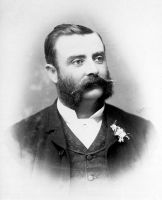William Pitt (architect)
| William Pitt | |
|---|---|

Portrait as Mayor of Collingwood in 1891
|
|
| Born |
4 June 1855 Melbourne, Victoria |
| Died | 25 May 1918 (aged 62) Abbotsford, Victoria |
| Nationality | Australian |
| Occupation | Architect |
| Buildings | Princess Theatre, St Kilda Town Hall, Queens Bridge, Bryant and May Factory, Wellington Opera House, Rialto Buildings, Olderfleet Buildings, Victoria Brewery. |
William Pitt (4 June 1855 – 25 May 1918) was an Australian architect and politician. Pitt is best known as one of the outstanding architects of the "boom" era of the 1880s in Melbourne, designing some of the city's most elaborate High Victorian commercial buildings. He worked in a range of styles including Gothic Revival, Italianate, French Second Empire, and his own inventive eclectic compositions. He had a notable second career after the crash of the 1890s, becoming a specialist in theatres and industrial buildings.
William Pitt was born in 1855 in Melbourne two years after his parents emigrated to Australia from Sunderland in England. His father, also William Pitt, ran some of the most notable cafes in Melbourne and was a practising artist. Raised in the suburb of St Kilda, he was educated at the Hofwyl School in St Kilda [1] later attended George Henry Neighbour's college in Carlton. He later moved to the suburb of Abbotsford.
In 1875 Pitt was articled to the architect George Browne, who was something of a prodigy himself, designing the Rupertswood mansion, Her Majesty's Ballarat and The Theatre Royal on Bourke Street in the early 1870s, when he was in his mid 20s.
Pitt began his own architectural practice in 1879 at the age of 24 after winning the competition for the Melbourne Coffee Palace Bourke Street (between Swanton and Russell Streets). His design of an elaborate Renaissance Revival style facade over five storeys set the tone for the level of detail he would lavish on his subsequent boom era designs.
Competition wins marked the success of his early years, winning that for an equally elaborate Renaissance Revival Premier Permanent Building Society (1882), and the Falls Bridge (Queens Bridge) in the same year (not built),
...
Wikipedia
